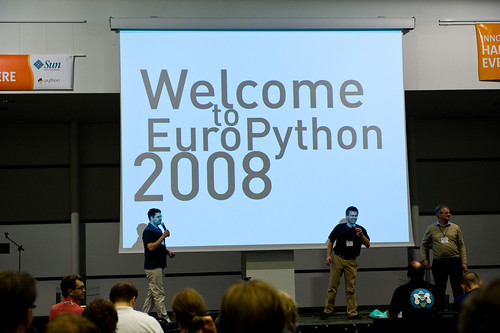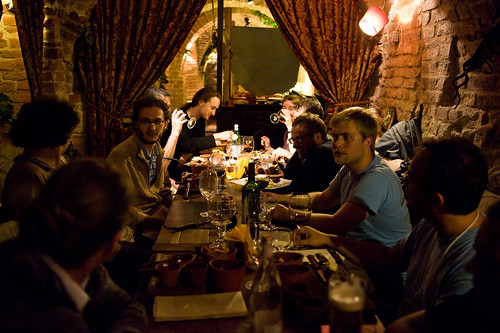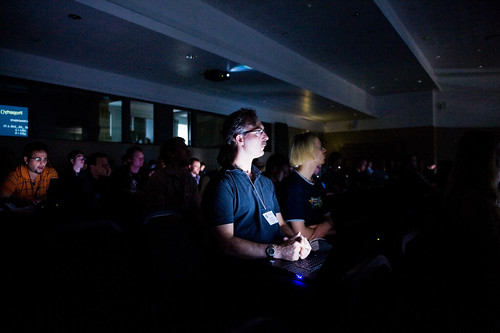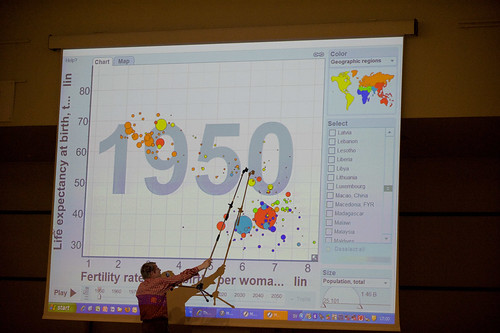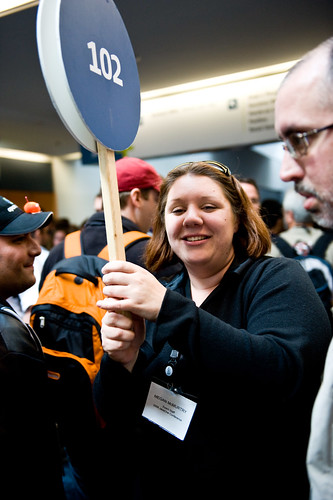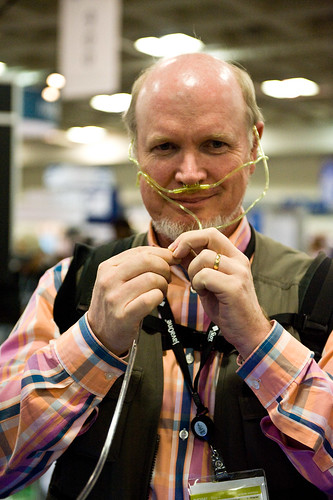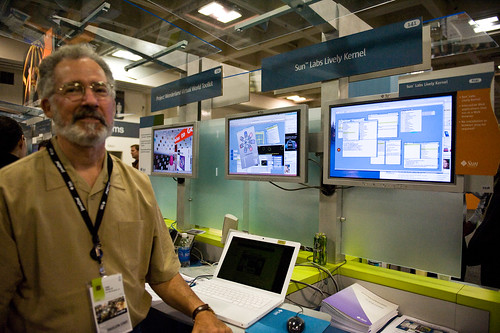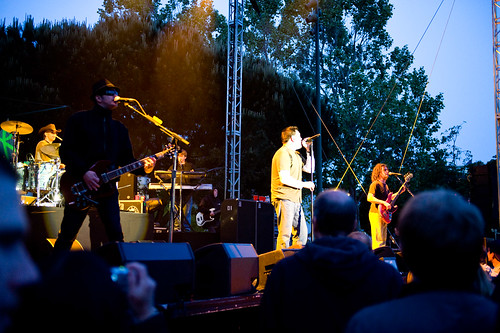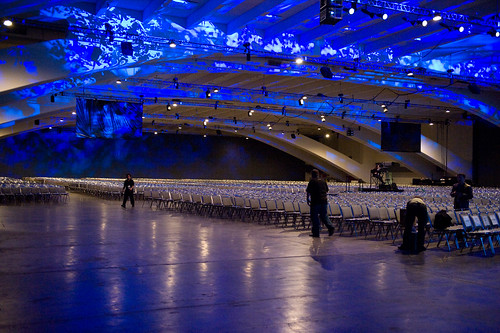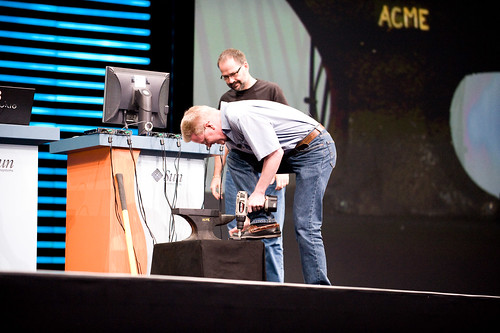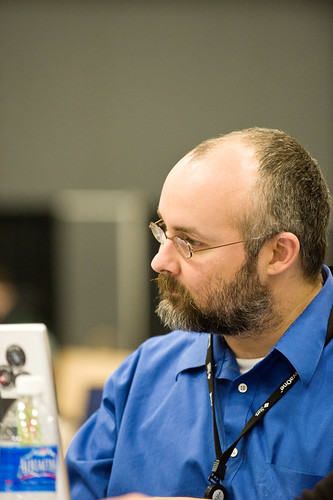I am slowly recovering from the transatlantic flights for PyCon UK, so I think that I’m ready to give a report.
The conference
In Europe, at least, the Python community seems to be sprouting more regional conferences as opposed to having the single EuroPython conference. This probably makes it easier for people to get to a conference, but it also means that people like me have to travel more in order to attend all these meetings. PyCon UK, also takes place over a weekend, again to facilitate people being able to attend without the hassle of getting time off from work and so forth. The conference was roughly the size of EuroPython, with attendance in the 230-250 range.
As usual, I did some of the regular program and some hallway track. The top three talks that I went to were Jacob Kaplan-Moss‘s update on the new stuff in Django 1.0 (that’s Jacob in the picture above). Chris Withers did a good talk on the problems with Python package management. The basic answer there is that a lot of stuff layered on top of a shaky foundation, in this case, distutils. Chris discussed some (partial, in my opinion) solutions to the problems, the virtualenv and buildout packages. Perhaps one day there will be a really good solution. Micheal Sparks from BBC research described the Kamaelia project, which includes a Software Transactional Memory (STM) module. I am neutral on the benefits of transactional memory, so I am glad to see that someone in the Python community is exploring how STM might fit with Python. Slides for some of the talks are being posted on the conference wiki. In the hallway track, I attended a BOF for Python Bloggers, and a PGP keysigning. I also had some excellent extended conversations with Holger Krekel and Maciej Fijalkowski of PyPy, Adewale Oshineye from Google, and Michael Foord from Resolver Systems.
I was invited to give one of the two keynotes for the conference, and my topic was “Challenges for Dynamic Languages”. I tried to step back from the specifics of Python and look at some of the challenges that face all of the dynamic language communities if we want to gain broader adoption of dynamic languages. I was somewhat concerned when Mark Shuttleworth covered some of the same topics during his keynote the day before, but maybe it’s a good sign when people from two different organizations and backgrounds can come to similar conclusions about the future of Python and related languages. My presentation is very picture oriented, without a lot of text or bullet points, so I am not sure whether posting the slides will actually help anyone or not. This was my first time giving a keynote, and it seems like it was well received, despite some laptop/projector interaction problems. Thanks to Jacob Kaplan-Moss for saving the day by lending me his MacBook Pro, remote, and memory stick.
Travel
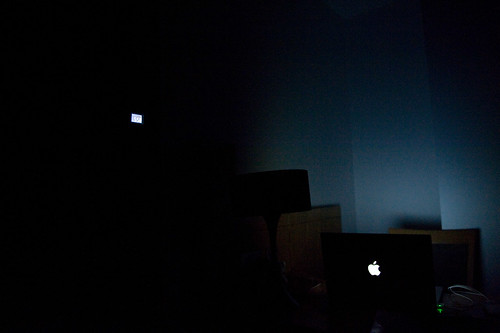
This was my second transatlantic flight since June, and it seems that I really can’t sleep on long airplane flights. This turns the 10 hour flight from Seattle to most Star Alliance hubs into a pretty long ordeal. I did manage to finish a book and read a few papers, but I spent way too much time using the in flight entertainment system (I prefer Lufthansa’s to SAS’s). I also experienced my longest wait (1 hour) in passport control in the Birmingham airport. During that wait, I listened to the two American women right in front of me discovering that each of them was moving to the UK to marry an Englishman. Ten people or so before I reached the inspectors, a passenger collapsed in an epileptic fit (no previous history apparently), just to make sure things were memorable.
I was only in Birmingham for two and a half days, and spent almost two days inside of airplanes. Several people commented on the jet lag, which didn’t seem that bad until it caught up with me when I finally arrived home.
Photography
Photographically, perhaps the bigger story is the pictures that I didn’t get. The D3 does not fit in my camera/computer bag with a lens mounted on it, which means that it is hard to get shots where you just need to pull the camera out, point and shoot. I had a flight leg from Seattle to Frankfurt, and on the Frankfurt end we took busses from the airplane to the terminal. While we were waiting for all the passengers to board the bus, I realized that I was staring at a great view of the rear left quarter of an Airbus A330-300. Perfect for a wide angle shot, but there wasn’t enough time to get the shot.
When I arrived on Thursday, I went over to the Pycon UK social, had some dinner and hung out. I left a little early when the noise level got to be more than I could handle. As I was walking back to the hotel, I saw some beautiful artwork that was being projected on the side of a building in Paradise Circle as part of Birmingham’s Light Night and Artsfest. I had left the camera at the hotel because I didn’t want to have to haul it around, but I was so taken with the display that I went and picked it up. Here’s some of what I saw:
This is a shot as I walked back to my hotel via one of Birmingham’s canals.
Here‘s the rest of the set. There are not many pictures of the conference proper — I go to a lot of conferences now, and I’ve shot enough pictures of people sitting in rows or giving a talk. There’s an entire group on Flickr for PyCon UK if you want better coverage of the conference.









